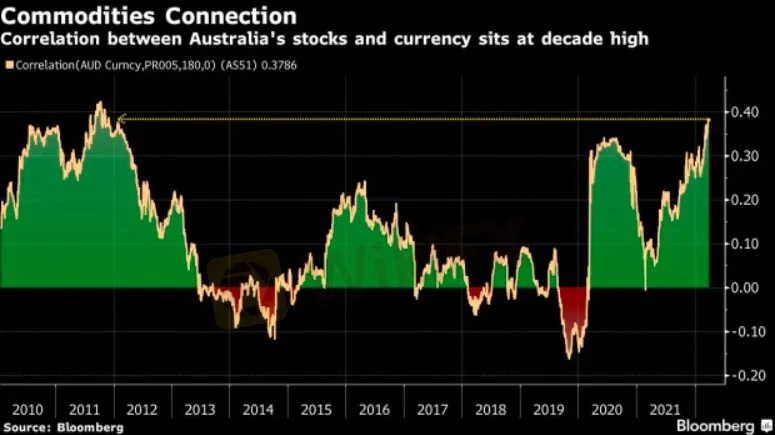简体中文
繁體中文
English
Pусский
日本語
ภาษาไทย
Tiếng Việt
Bahasa Indonesia
Español
हिन्दी
Filippiiniläinen
Français
Deutsch
Português
Türkçe
한국어
العربية
Commodities Boom Sends Aussie, Stocks Correlation to Decade-High
Abstract:Pedestrians are reflected in a window as they walk past an electronic stock board at the ASX Ltd. exchange centre in Sydney, Australia, on Thursday, Feb. 14, 2019.
The relationship between Australias equities and currency has become the closest in a decade as commodity prices surge.

The 180-day correlation between the country‘s stock benchmark and the Australian dollar has climbed to the highest level since late 2011, according to data compiled by Bloomberg. The strengthened ties come as rallies in materials from oil to iron ore have boosted both the nation’s equities and the Aussie.
Commodity-price movements stand out as a “common theme” in times of high correlation between the two assets, said Carl Capolingua, an analyst at ThinkMarkets Australia. The connection between Australias shares and currency “tends to be the highest during some pretty significant macroeconomic dislocation,” he said.
Energy and materials stocks are among the top gainers this year on the S&P/ASX 200 Index, with the former surging 28% and the latter rising 11%. The two sectors make up almost 30% of the broader gauge, their highest weighting since 2011, data compiled by Bloomberg show.
While miners have long been one of the largest components in Australia‘s stock market, their weighting has increased following the unification of BHP Group Ltd. The world’s biggest miner became the indexs largest stock after the company scrapped its dual-listing structure in January.
Australias dollar has strengthened about 3% this year to make it the best-performing Group-of-10 currency over the period. The Aussie, which traded at 74.79 U.S. cents Friday, has surged more than 7% since touching its lowest in more than a year in late January.
‘Remain Elevated’
“With supply constraints and the Russia-Ukraine war continuing, commodity prices will remain elevated,” potentially pushing the Australian dollar up to 80 cents in the next six months, said Russel Chesler, head of investments and capital markets at VanEck Associates Corp. in Sydney.
Surging commodity prices arent the only things propelling both assets. Bets on tighter monetary policy have boosted the Aussie and share prices of local banks, the largest sub-group on the stock benchmark.
Still, a strong currency hasn‘t always been a boon for the economy or the nation’s stocks. It can reduce the value of earnings from commodity exports, which are priced in U.S. dollars, and hurt profitability at tourism and education companies by raising the costs for foreign purchasers.
In addition, the S&P/ASX 200 Index dropped 15% in 2011, its worst year outside the global financial crisis in 2008, after the Australian dollar rose above $1.10 for the first time since it was freely floated in 1983.
Disclaimer:
The views in this article only represent the author's personal views, and do not constitute investment advice on this platform. This platform does not guarantee the accuracy, completeness and timeliness of the information in the article, and will not be liable for any loss caused by the use of or reliance on the information in the article.
Read more

Crypto, Euro, Yuan: Still No Dollar Killer
Despite frequent “de-dollarization” headlines, the U.S. dollar remains unrivaled due to unmatched market depth, global usability, and trusted legal/institutional frameworks. Crypto and other currencies (euro, yuan) lack the stability, convertibility, and infrastructure required to replace the USD, while the Fed’s credibility and the scale of U.S. financial markets continue to anchor demand. Bottom line: no alternative currently offers a complete, credible substitute for the dollar’s global role.

100% Tariff Incoming: Trump Announces November Hike on China
The U.S. will impose an additional 100% tariff on Chinese imports starting Nov. 1, 2025—potentially earlier—alongside new export controls on “critical software,” escalating tensions after Beijing’s rare-earth curbs, new port fees, a Qualcomm probe, and a halt to U.S. soybean purchases. Stocks fell on the news. Key context: some U.S.-China tariffs remain paused until Nov. 10, a Supreme Court case could reshape Trump’s tariff authority, new U.S. duties on cabinets (Oct. 1) and wood products (Oct. 14) are in force, and a pause on Mexico tariffs is set to end next month.

What is NFP in Forex? An Insightful Guide for Traders
The Non-farm Payroll (NFP) report may be for the US. However, the report, which is issued every month, impacts the forex market globally. The monthly report estimates the number of jobs gained in the US in the previous month. The job numbers stated on this report exclude those of farms, private households, and non-profit organizations. Usually released on the first Friday of the month, the report also includes the US unemployment rate, average hourly earnings, and participation rate. In this article, we have answered the question - what is NFP in forex - and shared other pertinent details. Read on!

Fed Rate Cuts May Not Happen in July, Markets Await Policy Meeting Minutes Release
Federal Reserve officials had a meeting on June 17-18 during which some of them expressed a fall in interest rates in July. However, a lot of policymakers are still worried about the inflationary pressures that might emerge from US President Donald Trump’s import tariff decisions aimed at changing global trade. So, it seems the rate cut may not happen in July. Read this to know more.
WikiFX Broker
Latest News
2 Malaysians Arrested in $1 Million Gold Scam Impersonating Singapore Officials
Moomoo Singapore Opens Investor Boutiques to Strengthen Community
OmegaPro Review: Traders Flood Comment Sections with Withdrawal Denials & Scam Complaints
An Unbiased Review of INZO Broker for Indian Traders: What You Must Know
BotBro’s “30% Return” Scheme Raises New Red Flags Amid Ongoing Fraud Allegations
The 5%ers Review: Is it a Scam or Legit? Find Out from These Trader Comments
WikiEXPO Dubai 2025 Concludes Successfully — Shaping a Transparent, Innovative Future
Admirals Cancels UAE License as Part of Global Restructuring
Forex Expert Recruitment Event – Sharing Insights, Building Rewards
Exness Broker Expands in South Africa with Cape Town Hub
Currency Calculator



